Scottish Economic Statistics 2008
This is the ninth edition of the annual publication Scottish Economic Statistics, which is produced by statisticians in the Scottish Government.
B4 chapter four: Labour Market
Population
The latest estimate of Scotland's population published by the General Register Office for Scotland ( GROS) is 5,144,200 (as at 30 June 2007). This is an increase of 27,300 on the previous year and an increase of 80,000 since mid-2001.
Scotland's population has been increasing over the past five years. This follows from a period of population decline since the mid-1970s (where the population peaked at 5.24 million in 1974) falling to a low of 5.05 million in 2002. Since 2002, the population has been increasing although the increases are relatively small (averaging less than 0.5 per cent per year).
Looking forward, the population is projected to rise to 5.37 million in 2031 before changing direction and slowly declining, falling
below 5 million in 2076. These population projections are based on the estimate of Scotland's population at 30 June 2006.
In 2007, 18 per cent of Scotland's population was below working age (aged under 16 years), 63 per cent were of working age (16-59 for females and 16-64 for males) and the remaining 19 per cent of pensionable age. Population projections indicate that the number of younger people (aged under 16 years) is projected to decrease by 7 per cent between 2006 and 2031 whilst the number of people of pensionable age is projected to increase significantly by around 31 per cent. These projected demographic changes will have implications for the labour market in Scotland, with the number of people of working age projected to increase slightly by around 0.4 per cent during the same period. These figures take into account the increases in the state pension age.
Table 4.1 shows the variation in the age structure across Scotland's Local Authority areas. In Edinburgh City 68.0 per cent of the population are of working age whereas in Dumfries & Galloway only 58.1 per cent of the population are of working age.
Employment
The official source for estimating the number of people in employment is the Labour Force Survey ( LFS). LFS estimates from 1992 onwards have recently been revised by the Office for National Statistics following a reweighting exercise and the annual seasonal adjustment review (see Box 4.1 for further details).
In 2008 (April to June) there were 2.54 million people aged 16 and above in employment, a decrease of 0.5 per cent on the same period a year earlier, but an increase of 7.8 per cent since 2001.
The proportion of working age people in employment varies geographically across Scotland. This is illustrated in Map 4.1 using the Annual Population Survey ( APS). The APS combines results from the annual Labour Force Survey ( LFS) with a boost to the sample in Scotland, providing more reliable Local Authority level data.
The data provided in Map 4.1 is used to measure the Scottish Government's Purpose Target on Cohesion which is to narrow the gap in participation between Scotland's best and worst performing regions by 2017. Latest estimates from the 2007 APS (Jan-Dec) show that the gap between the average employment rates for the best performing three local authority areas and the three worst performing local authority areas was 16.2 percentage points. The gap has narrowed from 2001 when it was 21.8 percentage points. Last year, the gap was 15.5 percentage points so there has been a slight increase over the year.
Box 4.1: Labour Force Survey Reweighting 2008 As the Labour Force Survey ( LFS) is a sample survey, the responses reflect only a small proportion of the total population. Each respondent is given a weight relating to the proportion of the total population that he or she represents. The sum of all the weights equals the total household population for the survey. Reweighting means assigning different weights that are derived from more up-to-date population estimates. Prior to the current reweighting exercise, the LFS data were last reweighted using population estimates published in Spring 2003. Since then the population estimates have been revised every year when the latest mid-year estimates are published in August. This causes revisions to the population projections for the most recent years. On 14 May 2008, the Office for National Statistics ( ONS) released labour market statistics based on LFS and APS1 datasets weighted to population estimates published in 2007. The LFS and APS estimates published in Scottish Economic Statistics are consistent with the reweighted microdata. Further information on the reweighting and its impact on headline labour market indicators can be found at the link below: |
1 Annual Population Survey (boosted annual version of the Labour Force Survey).
Map 4.1: Employment rates by Scottish Local Authority area, 2007
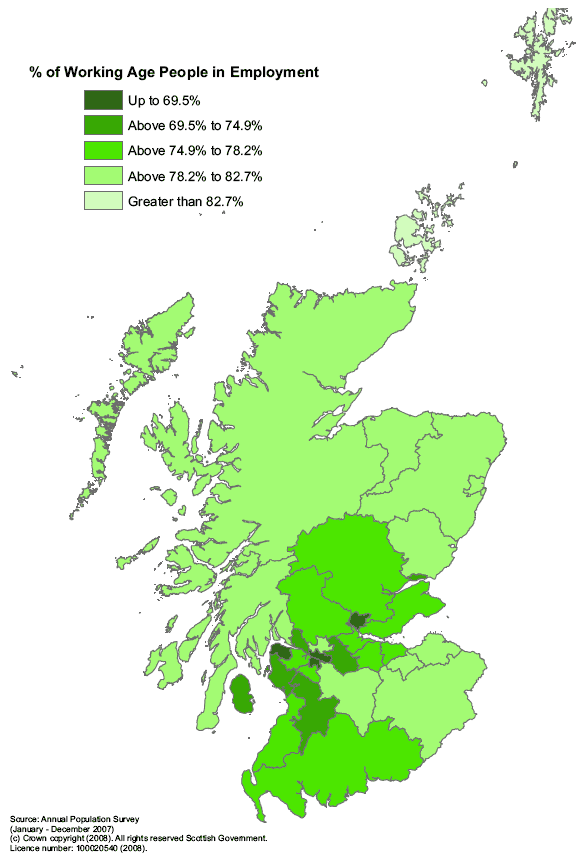
Gender and Age
Table 4.2 shows that the employment rate for both males and females has increased since 2001 although there has been a slight decline over the past year. In 2008 (April to June), there were 1.21 million females in employment, an increase of 7.7 per cent since 2001 but a decrease of 0.2 per cent over the year. The number of males in employment in the three months to June 2008 was 1.33 million, up 7.7 per cent since 2001 but down 0.8 per cent over the year.
Chart 4.1 shows that the proportion of people in employment aged 30-49 and 50+ has increased since 2001. However, there has been a decline in the employment rate for younger people aged 16-29.
Chart 4.1 Employment rate by age group, Scotland, 2001-2008
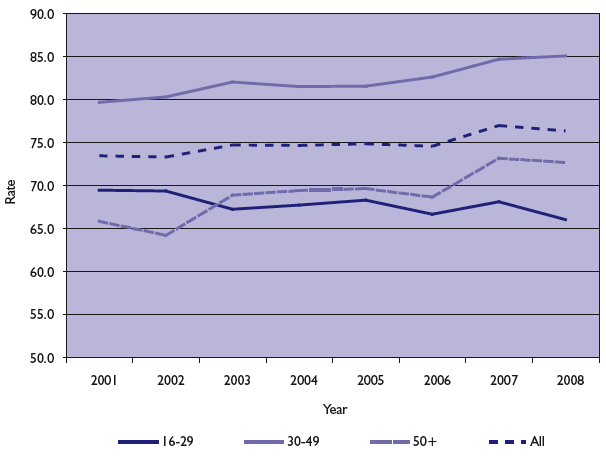
Source: Labour Force Survey, Office for National Statistics
Calendar Quarter 2 (April-June), Not Seasonally Adjusted
Note: Working age is 16-59 for females and 16-64 for males.
Work Pattern
Employment comprises of employees, self-employed, unpaid family workers and government supported trainees. Full-time employment has increased by a greater amount for females (13.1 per cent) than for males (5.0 per cent) since 2001. The number employed on a part-time basis has also increased since 2001, but fallen slightly in the last couple of years before showing an increase again over the last year.
This increase in part-time working has been greater for men than for women. Number of part-time men has increased by 39.0 per cent since 2001 whereas for women, the increase
is 1.1 per cent. Overall, in 2008, part-time workers accounted for a quarter of all people in employment.
Since 2001 self-employment has increased by 21.2 per cent. Female self-employment increased by 53.3 per cent and male self- employment increased by 10.9 per cent over the period. The majority (69.5 per cent) of self-employed workers are male.
Qualifications and Job Training
In 2008 (April to June) 28.6 per cent of people had received job-related training in the last three months. This compares with 27.1 per cent in 2001. The proportion of people in the workforce who have a degree has also been increasing in Scotland (Chart 4.2). In 2008 (April to June), 24.7 per cent of people in employment aged 25 to state pension age held a degree level qualification or above. This compares with 18.1 per cent in 2001.
Chart 4.2: Percentage of people aged 25-59/64 in employment with degree level qualifications or above, Scotland, 2001-2008
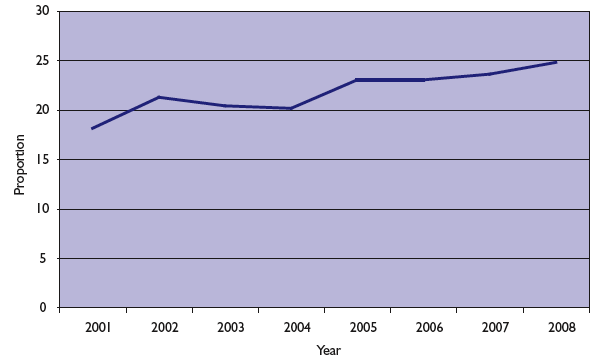
Source: Labour Force Survey, Office for National Statistics
Calendar Quarter 2 (April-June), Not Seasonally Adjusted
Chart 4.3 shows that the proportion of working age people in employment with low or no qualifications ( SCQF level 4 qualifications or below) is decreasing. These data are used as a proxy measure to inform the Scottish Government's National Indicator on literacy and numeracy as they are currently developing a new national survey to collect data on working age people with severe literacy and numeracy problems. The indicator aims to reduce the number of working age people with severe literacy and numeracy problems. The latest figures for the April to June quarter show a reduction in the proportion of working age people with low or no qualifications from 21.1 per cent in 2001 to 13.8 per cent in 2008.
Chart 4.3: Percentage of working age people with SCQF level 4 qualifications or below, Scotland, 2001-2008
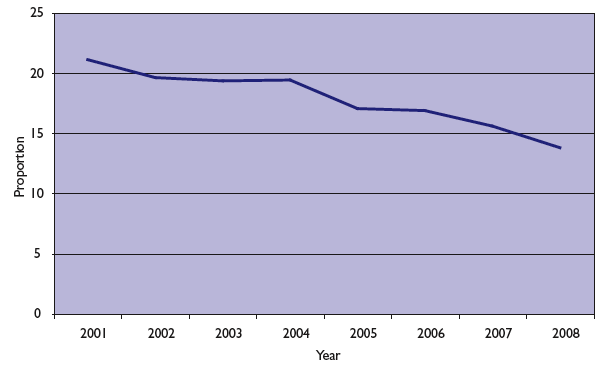
Source: Labour Force Survey, Office for National Statistics
Calendar Quarter 2 (April-June), Not Seasonally Adjusted
Note: Working age is 16-59 for females and 16-64 for males.
Jobs
Official sources of workforce jobs are the Annual Business Inquiry and the Quarterly Employee Jobs series. These are surveys of employers carried out by the Office for National Statistics ( ONS). These surveys measure number of jobs, whereas the Labour Force Survey primarily measures the number of people in employment. Employment and jobs are not the same as a person can have more than one job.
Industry
Chart 4.4 shows the distribution of employee jobs by broad industry sector in 2006. The highest proportion of employee jobs in Scotland were in Public Administration, Education & Health (30.4 per cent).
Comparisons with earlier years are not possible as the Annual Business Inquiry data for 2006 are subject to three discontinuities. Further details are available from NOMIS; a web database providing information and access to a range of official labour market statistics: www.nomisweb.co.uk .
Chart 4.4: Distribution of employee jobs by industry, Scotland, 2006
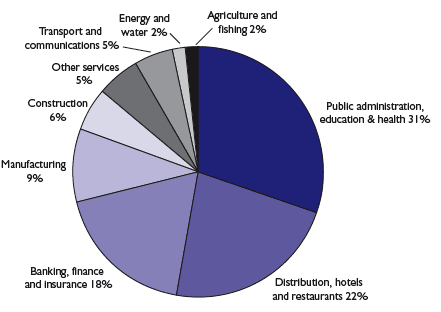
Source: Annual Business Inquiry
Unemployment
There are two measures of unemployment used in the UK:
- Unemployment (previously known as ILO unemployment) - This International Labour Organisation ( ILO) measure of unemployment is derived from Labour Force Survey data. It covers people who are: out of work, want a job, have actively sought work in the previous four weeks and are available to start work within the next fortnight; or out of work and have accepted a job that they are waiting to start in the next fortnight.
- Claimant count counts the number of claimants of unemployment-related benefits on the Jobcentre Plus administrative system. These are currently the Jobseeker's Allowance ( JSA) and National Insurance credits, claimed at Jobcentre Plus local offices. People claiming JSA must declare that they are out of work, capable of, available for and actively seeking work during the week in which the claim is made. They enter into a Jobseeker's Agreement setting out the action they will take to find work and to improve their prospects of finding employment.
The unemployment rate obtained from the Labour Force Survey is the preferred measure of unemployment. The unemployment rate is less reliable for small areas and therefore the claimant count unemployment rate is also a key indicator of unemployment. However, in July 2006, ONS published, for the first time, modelled unemployment rates. These provide unemployment rates under the preferred ILO definition for local authority areas (see Box 4.2).
Estimates of modelled based unemployment by local authority area are provided in Table 4.4.
Box 4.2: Model-Based Estimates of Unemployment For small areas, for example local authorities, even the annual LFS or APS has small samples. This means that estimates from the LFS/ APS for these areas are likely to be less reliable than those for larger areas since the sampling variability is high. In particular, this will affect estimates of events which are not common. An example of this is unemployment (formerly International Labour Organisation ( ILO) unemployment). A statistical model has been developed to provide reliable unemployment estimates for all local authorities. The model is a multilevel model that uses annual LFS/ APS data, by age and sex, but also uses counts of claimants of Jobseeker's Allowance (claimant count) to calculate the estimates. The claimant count is an administrative measure, and so is known accurately for all areas. Also, it is highly correlated with unemployment. The model is said, therefore, to borrow strength from the claimant count. The model also includes a socio-economic area indicator and a 'random' area effect. The relationship between claimant count and the number of unemployed may be different in two areas in spite of them sharing the same factors in the model. The random area effect is included in order to model these random local differences. The inclusion of the random effect gives the model-based estimates the property that, under sufficiently large sample conditions, they will coincide with the direct survey estimates. APS data are published quarterly (but covering a year's data) for the periods January to December, April to March, July to June, and October to September. The model-based estimates, using APS data and claimant count data referring to the same periods, are similarly produced quarterly. Further information, and detailed user guidance on the model-based estimates, are given at |
Chart 4.5 shows that the unemployment rate obtained from the LFS is higher than the claimant count rate for Scotland and the UK. Between 2001 and 2005, Scotland's unemployment rate was above that of the UK. However the gap was closed in 2006 and Scotland now has a lower unemployment
rate (at 4.2 per cent) compared to the UK
(5.4 per cent) (April to June 2008). Scotland's claimant count rate remains above the UK's however the gap has narrowed considerably in recent years.
Chart 4.5: Claimant Count and Unemployment Rate, Scotland & UK, 2001-2008
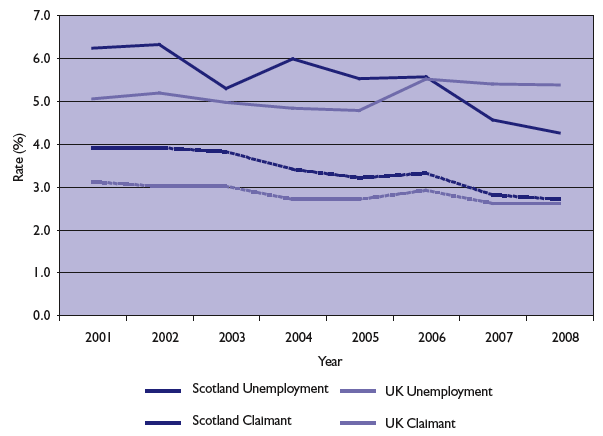
Source (1): Unemployment, Labour Force Survey, Office for National Statistics
Calendar Quarter 2 (April-June), Seasonally Adjusted
Source (2): Claimant Count Rate, Office for National Statistics
June each year, Seasonally Adjusted
Economic Activity & Inactivity
The labour market can be divided into two groups, the economically active and inactive. The economically active population are people who are either in employment (employee, self-employed, unpaid family worker or on a government supported training programme) or unemployed and actively seeking work. The economically inactive are people who are not in work, but who do not satisfy all the criteria for unemployment, such as those not actively seeking work or those not available for work. Reasons for economic inactivity include looking after the family/home, being a student, being sick/disabled, retirement etc.
Table 4.2 provides estimates of the levels of economic activity and inactivity for males and females over the past few years.
Benefits
The claimant count is the number of people in receipt of Jobseeker's Allowance ( JSA). Analyses of the number of claimants of Incapacity Benefit and those claiming Income Support can identify those who would be classified as inactive. JSA is mutually exclusive from Incapacity Benefit and Income Support. Using all these benefit figures captures people who are not working and includes people who are looking for work and those not looking for work. Benefit figures are sourced from the Work and Pensions Longitudinal Study, which is maintained by the Department for Work and Pensions. Map 4.2 shows the distribution of number of claimants of workless benefits ( JSA, Incapacity Benefit and Income Support) throughout Scotland. Using benefits information in addition to LFS information gives a more detailed picture of the labour market in Scotland.
Map 4.2: Claimants of workless benefits (Jobseeker's Allowance, Incapacity Benefit and Income Support) by Local Authority, February 2008
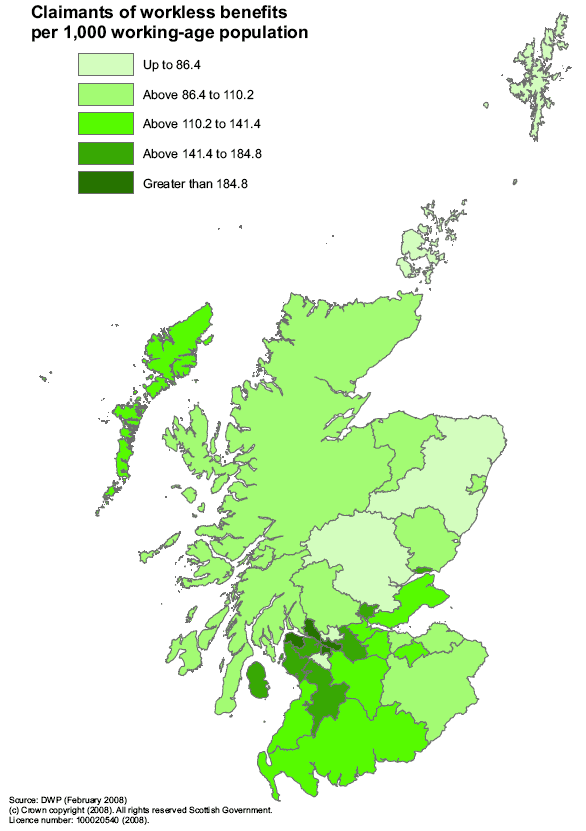
Source: DWP, GROS
Earnings
The Annual Survey of Hours and Earnings ( ASHE), which replaced the New Earnings Survey ( NES), is the official source of earnings information. Median gross weekly earnings in Scotland, in April 2007, for full-time employees were £441.50. Scotland was ranked fourth out of the twelve government office regions in the UK. In Scotland, in April 2007, median gross weekly earnings for full-time employees were 96.7 per cent of earnings for the UK.
The increase in median weekly earnings for full-time employees in Scotland in the year to April 2007 was 3.1 per cent; this was higher than the UK increase of 2.9 per cent. Scotland was ranked fifth amongst the twelve government office regions of the UK, in terms of the annual percentage growth in median weekly earnings for full-time employees over the period to April 2007.
In April 2007 median earnings in Scotland were highest for those living in East Renfrewshire (£522.60) and lowest for those living in Moray (£377.30).
Gender Pay Gap
In April 2007, median full-time hourly earnings (excluding overtime) for women at £10.22 were lower than that for men at £11.61. That is female earnings were 88 per cent of male earnings giving a gender pay gap of 12 per cent. Table 4.20 shows that the gender pay gap in Scotland has been narrower than that for the UK since 2003.
There is a problem
Thanks for your feedback